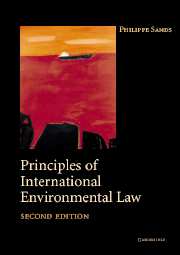Book contents
- Frontmatter
- Contents
- Foreword
- Preface and acknowledgments to the first edition
- Preface and acknowledgments to the second edition
- Table of cases
- Table of treaties and other international instruments
- List of abbreviations
- PART I The legal and institutional framework
- PART II Principles and rules establishing standards
- 6 General principles and rules
- 7 Human rights and armed conflict
- 8 Atmosphere
- 9 Oceans and seas
- 10 Freshwater resources
- 11 Biological diversity
- 12 Hazardous substances and activities
- 13 Waste
- 14 The polar regions: Antarctica and the Arctic
- 15 European Community environmental law
- PART III Techniques for implementing international principles and rules
- Index
12 - Hazardous substances and activities
- Frontmatter
- Contents
- Foreword
- Preface and acknowledgments to the first edition
- Preface and acknowledgments to the second edition
- Table of cases
- Table of treaties and other international instruments
- List of abbreviations
- PART I The legal and institutional framework
- PART II Principles and rules establishing standards
- 6 General principles and rules
- 7 Human rights and armed conflict
- 8 Atmosphere
- 9 Oceans and seas
- 10 Freshwater resources
- 11 Biological diversity
- 12 Hazardous substances and activities
- 13 Waste
- 14 The polar regions: Antarctica and the Arctic
- 15 European Community environmental law
- PART III Techniques for implementing international principles and rules
- Index
Summary
Introduction
International environmental law has tended to regulate specific environmental media and/or resources rather than particular activities or products. There is, however, a significant emerging body of rules which regulate those activities or products considered by the international community, within a region or globally, to be hazardous or dangerous and to merit specific attention. This chapter describes those rules by reference to international regulation of five areas, namely: (a) accident prevention, preparedness and response; (b) the classification, international trade, and transportation of hazardous chemicals and pesticides; (c) the working environment; (d) radioactive materials; and (e) biotechnology. This chapter also identifies and outlines the main international regulations which address activities considered to be particularly damaging to the environment, such as energy, mining, transport and agriculture. It will be apparent that the past few years have seen significant developments, in particular the adoption of legally binding instruments on international trade in chemicals and pesticides (1998), on trade and marketing of living modified organisms (2000) and on the production and use of persistent organic pollutants (2001).
- Type
- Chapter
- Information
- Principles of International Environmental Law , pp. 618 - 674Publisher: Cambridge University PressPrint publication year: 2003



